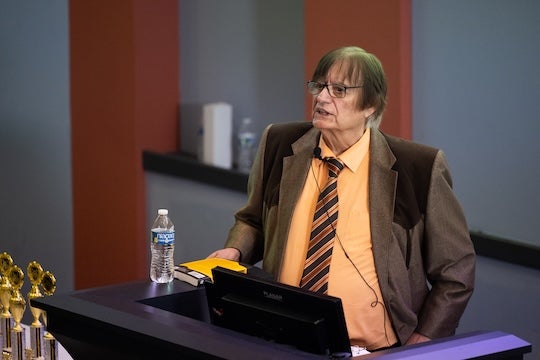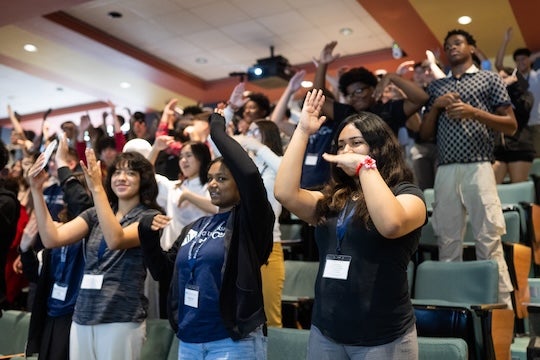More than 500 students in grades eight through 12 traveled from as far away as England and Thailand to attend summer Science, Technology, Engineering and Mathematics (STEM) Camps led by the Tapia Center at Rice University. In addition to delivering the Tapia STEM Camps, the Tapia Center also provided curriculum to an additional 750 students across the Gulf Coast region.

Founded by Richard Tapia, University Professor and the Maxfield and Oshman Professor of Engineering, the camps aim to encourage students from all communities to pursue careers in STEM.
“True success is not the education that you have but what you do with it. It’s not the hand that you are dealt but how you play that hand,” Tapia shared with the students. “Failure is a part of every successful person’s life. You must learn to grow from your failures and to develop compassion and sensitivity from your tragedies. Continue to dream. Dreams are beautiful. Work to make them come true.”
This year marks more than eight years of collaboration on the summer program between ExxonMobil and the Tapia Center, which has expanded the camps’ reach and resources for high school students. Michael Butler, public and government affairs manager at ExxonMobil Pipeline Co., expressed enthusiasm for the partnership.

“We are thrilled to have this ongoing relationship with Rice and the Tapia Center, exposing kids to STEM activities and showing them that STEM is for everybody,” Butler said. “It isn’t just for a select few. Anybody can do it, and encouraging these young men and women to consider a career in STEM is something our corporation believes in and supports.”
The Tapia Camps are also made possible by the support of the H-E-B Tournament of Champions Charitable Trust, Robert S. Kaplan, the IF/THEN initiative of Lyda Hill Philanthropies and the Rice 24-Hour Challenge.
Hands-on learning and college preparation
Led by Rice faculty and staff, the Tapia Camps emphasize communication and teamwork as essential skills for a successful career in STEM. Campers engage in public speaking and collaborate on projects before presenting their final work to peers and professors, including Tapia.
The 2025 curriculum focused on three main topics: carbon capture and storage, computer science and college admissions and techniques used by professional mathematicians.

The highlight of the curriculum was the Tapia Carbon Project, where students learned about carbon capture and storage as a strategy for mitigating global warming. In it, they competed to build a model carbon storage reservoir using pasta, Play-Doh and vegetable oil.
The summer camp also provides students with a glimpse into college life.
“Campers learn from current undergraduate and graduate students, experience life on a college campus, eat the food college students eat, live in their dorms and take classes in the same rooms,” said Paul Hand, executive director of the Tapia Center. “They get a fun week away from home to experience what it’s like to be at college.”
Student experiences and lasting impressions
For 16-year-old Mylan Bavin from Dallas, attending the Tapia STEM Camp provided an opportunity to learn and visit the university campus.
“I learned about carbon capture and storage, how to work in a group and what it feels like to attend college lectures,” Bavin said. “I’ve heard about Rice for a long time, and it has been a dream school in my head, but I had never actually gotten the opportunity to go here and see the campus until now.”
The experience was one that Mercedes Hernandez, 15, from Mexico, said she would like to repeat.

“We were learning a lot of stuff here, like chemistry and CCS,” Hernandez said. “But also, I’ve met wonderful people and I’ve had amazing moments here. If I get the chance, I’d like to be here next year.”
Mahmoud Sutaif, 16, from Houston, described the week as unforgettable.
“We had fun and met a lot of friends,” Sutaif said. “It was my first time visiting this camp and Rice. I am going to study more, so maybe one day I can enter this university because I love it so much.”
Tapia’s enduring legacy
Tapia’s contributions to STEM education are widely recognized. In 1992, he became the first Hispanic elected to the National Academy of Engineering.
He served on the National Science Board, appointed by former President Bill Clinton, and has received numerous accolades, including the National Medal of Science from former President Barack Obama in 2011.
Since 2015, the Tapia STEM Camps have grown from 40 participants per year from Texas to more than 1,000 from across the Gulf of Mexico region and beyond.

